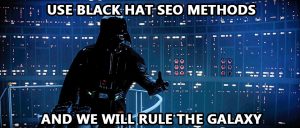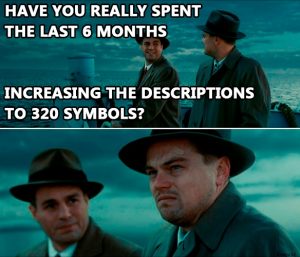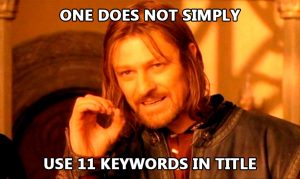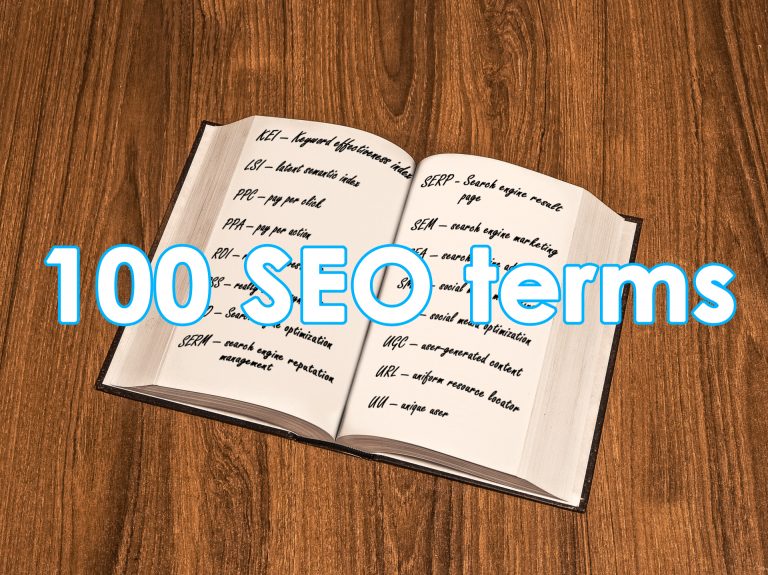Have you ever had troubles, speaking to an SEO-specialist? All these SERP, LSI, doorways, backlinks and other terrifying words, which seem very important, but completely incomprehensible. Let’s make a little phrasebook of the most used SEO terms to navigate you through the mysterious lands of the search engine optimization.
– 3 – 4 – A – B – C – D – G – H – I – K – L – M – N – O – P – R – S – T – U – W – Y
301 — a response server code that means a permanent redirect.
404 — a response server code that means that the server could not find the requested page.
404 page — specially customized page that is shown every time the 404 error occurs.
Interesting fact about the SEO term: Nowadays, creatively decorated 404 page is often used as a marketing tool.
AdWords, or Google AdWords — Google advertising program that works by pay per click principle.
Interesting fact about the SEO term: On the average, each $1,6 spent on advertising brings $3 in revenue.
Affiliates — websites that are the property of one owner and provide identical information, but are not mirrors. They are being created to oust competitors on SERP for specific search queries. Are regarded by search engines as a not fair competition and entail sanctions.
Alexa Rank — rating indicator, provided by Amazon. It is based on the number of visitors and page views.
Interesting fact about the SEO term: The lower this indicator is, the better the ratings are.
Alts, alt text — this SEO term stands for an HTML attribute that contains some text information, describing the element to which it refers. In most cases, it is used with some images, pictures, and other graphic elements. It is shown to the user only if the element that it is applied to cannot be rendered. Keywords used in alt tags can be useful to provide traffic from Google Images.
Interesting fact about the SEO term: Alternative text should correspond to what is shown in the picture. It should be laconic, informative and not spammed with keywords – one is enough.
Anchor — a visible part of the hyperlink, hiding the URL behind itself. It is regarded by search engines as one of the ranking factors, so including some keywords to the anchor can positively affect the position of the linked page on SERP. Still, you have to remember that the text of the anchor should correspond to the content of the page. And be sure to follow the natural ratio of anchor and non-anchor (those that use URL both as an address and an anchor text) backlinks.
Interesting fact about the SEO term: the percentage of anchor backlinks in the links profile of the website should not exceed 10%.
Assessor — search engine representative that checks sites for compliance manually. Some kind of a Jedi in the SE galaxy and a real nightmare for optimizers utilizing black hat SEO.
Backlinks — incoming links to the website from any other resource. Affects the domain authority, depending on what is the authority of the donor site.
Interesting fact about the SEO term: Search engines regard backlinks as votes in favor of the website they point to.
Baidu — search engine #1 in China and the third most popular in the world.
Interesting fact about the SEO term: Baidu SEO is not that easy. The fact is that this search engine gives preference to the websites that are in its possession. And this is about 20% of all traffic.
Bing — second most popular search engine in the world (3,23% of the market covered), the brainchild of the Microsoft.
Interesting fact about the SEO term: The name of this search engine stands for “Bing Is Not Google”.
Black hat SEO — optimization methods that are expressly prohibited by the search engines. As a rule, have signs of unfair competition. In modern realities are able to give only a short-term result with subsequent severe sanctions. The best tip about black hat SEO is quickly pass by those who advise to use it.

Blog — the category of websites on which the content is regularly updated. Characterized by the information orientation of the content. In SEO is used as a tool to expand the semantic core and to get additional traffic for queries that cannot be used in the structure of the main website.
Interesting fact about the SEO term: Blogger, free blog service that belongs to Google, is the most popular blog platform in the world.
Bounce rate — criteria, showing the percentage of users that come from the search engine to some page of the website and leave it without visiting any other page. Also called single-page session.
Breadcrumbs — some kind of a navigation element that shows the degree of nesting of the page relatively to the main one. For example, home > category > subcategory > product page, where each stage but the last one is clickable. It is good both for UX and SEO.
Cache — a web pages’ snapshots database. “Cached page” is a periodically taken copy of the live one, stored on servers of the search engine. Cached pages (not live ones) are used to form SERP.
Canonical page — rel=”canonical” link attribute is used to notify the search engines that the current page is a copy of the one that is marked as canonical, and should not be indexed. One of the ways to combat the duplicating content. By the way, we conducted an interesting research on the matter of using rel=”canonical” on pagination pages.
Interesting fact about the SEO term: rel=”canonical” is not a strict directive for the search engines, but some kind of a hint.
Cloaking — the black hat SEO method, based on the provision of different content to users and search engines. This can be making a text the same color as a background, putting it behind some other element, making it very little.
Interesting fact about the SEO term: sometimes the owners of the websites do not even guess that their resources are using cloaking. They can fall prey to unscrupulous optimizers, not caring about the consequences of their actions. Or, even worse, become a victim of hacking, without having any idea about this. In this case, the intruders use the hacked websites as link juice donors, hiding outlinks somewhere in the invisible part of the web page.
CMS — Content Management System. It is a program created to simplify the interaction with the website. As a rule, it incorporates the controls of the most important systems. Thus, site management is carried out without interference in the code.
Interesting fact about the SEO term: WordPress is the most popular CMS in the world. About 30% of all websites are running on WordPress!
Content — The contents of the site pages. This can be texts, images, tables, videos and any other types. From the search engines point of view, the main indicator of the quality of content is its ability to solve the user’s problem.
Interesting fact about the SEO term: Have you ever heard a postulate “content is the King“? Well, it was crowned by the search engines.
Copywriting — generic name for the text content creation process. Concerning search engine optimization, so-called SEO-copywriting is meant, featuring an emphasis on the use of keywords.
Interesting fact about the SEO term: this word comes from merging “copy” and “writing”. First, it was used to name the process of writing advertising and presentation texts. Nowadays, this word wrappers one more meaning – creating content for web resources.
CPC — Cost per click. The price of one action (click) in pay per click advertising.
Crawler (spider, search robot) – a program that moves through the sites in the web, following the links, to gather some data.
CTR — click-through rate. Denotes the ratio of impressions on SERP to clicks. This metric is needed to measure the level of efficiency.
Description, or meta description — short description of the page’s content. Sometimes it is used by search engines as a snippet displayed in search results, if they deem it relevant to the request and the content of the page. Despite description is no more a ranking factor, the way it looks like can have a direct impact on the CTR. Google loves to play around the amount of descriptions’ symbols shown in a snippet.

Doorway — this SEO term stands for a page that is created to be shown for some definite queries in search engines and to redirect users to some other page when they click it on SERP. This method is related to black hat SEO.
Duplicate content — content that is met more than once on the Internet or within one website.
Google — the most popular search engine worldwide, covering more than 90% of the market. Google is located on the crest of advanced technology, often being the developer and the carrier of these technologies.
Interesting fact about the SEO term: Up to 20% search queries that are being asked in Google every day are the new ones.
Googlebot — Google crawler that goes through web pages (following links) and makes a list for indexing.
Interesting fact about the SEO term: Googlebot is the main Google crawler. Still, there are some robots that Google uses to gather different types of information: APIs-Google, Mediapartners-Google, AdsBot-Google-Mobile, AdsBot-Google, Googlebot-Image, Googlebot-News, Googlebot-Video. You can read more about different types of Googlebots in this Google support article.
Google Panda — Google algorithm update, implemented in February 2011. It is aimed at pessimizing web pages with low-quality content. Low-quality means “thin content” (very little of relevant content on the page), duplicating content, content farming, low-quality user-generated content.
Interesting fact about the SEO term: Google Panda is named in the honor of Navneet Panda – the author of the technology that allowed to implement this algorithm.
Google Penguin — the code name of Google algorithm update that is aimed to penalize websites, abusing the backlinks mass manipulation. Being first applied in April 2012, Penguin had a significant impact on improving the quality of websites in the top.
Google Rankbrain — machine learning algorithm that aims to show the most relevant results to the search query taking into account the behavioral factors. Two main criteria – the CTR and the bouce rate.
Grey hat SEO — techniques that are forbidden by the search engines. Being not as frank as the methods of black hat SEO, they are still tricky and largely unfair. However, many methods that are presented as “white” ones by tricky SEOs are located on the very edge of the gray plane. For example, manual link building which is widely practiced by the search engine optimizers is not allowed by Google in any of its manifestations.
h1 — HTML tag that is positioned as the content heading. Should be used only once per page (however, repeated use will not be a mistake). Despite it used to be a very important ranking factor earlier, now its importance significantly decreased. Observance of hierarchical nesting when using h1, h2 and other sub-headings up to h6 will contribute to a better understanding of the page structure by the search engines.
Human-readable URL, or Clean, User-friendly, SEO-friendly, RESTful URL — URL that carries logical structure and, ideally, a semantic load in order to facilitate interaction with the resource. Do not contain illegibly-encoded data, includes only the clear path instead. website.com/categories/index.php?hfr=2&kjs=3&p=5 is an example of a bad URL, website.com/men/boots/evening-shoes/page-5 is human-readable.
Interesting fact about the SEO term: Despite it is stated that using a keyword in the URL is not a ranking factor anymore, it is very good from the UX point of view.
Impression — event that is equal to one page view.
Index — some kind of a web pages database that is collected and analyzed by the search engines to show in SERP. Pages are being kept in a commressed form – each page is a file in which for every word from the original web page the list of positions it occurs for is itemized.
Interesting fact about the SEO term: Google does not provide official information about the size of its index. Still, according to unofficial estimates, there are more than 4,46 billion pages in the Google index (June 2018).
Indexing — the process of evaluation, understanding and compression of the content of the web page by the search engine. At this stage, the search engine is assimilating the webpage with the search queries to show it for the correct ones.
Interesting fact about the SEO term: people often confuse indexing, scanning and caching.
Keyword — a word or phrase that is used to find some information in the search engine (search query). Search engine optimization is based on sharpening the pages of the website for relevant keywords, which users come to the search engine with.
Keyword research — a labor-intensive process of collecting all appropriate to some theme search queries that were used by users across the Internet in some definite period of time. It is needed to have a clear vision of how do people search for some subject. Comprehensive keyword research allows to create a general website structure and to get a list of landing pages that are to be created.
KEI — Keyword effectiveness index. This SEO term shows the ratio of the number of searches to the competitiveness of a keyword.
Landing page — a page of the website user gets onto from the search engine. Despite the common misconception, the landing page is actually any page that brings traffic from search engines.
Lead — the potential client that somehow responded to marketing communication (left his e-mail, filled out a form, passed a survey, etc.)
Lead generation — the process of getting contacts of potential customers interested in a product or service.
LSI — latent semantic index. An algorithm that is aimed to show not only verbatim results on SERP, but those ones that have the synonymous meaning and are revealing the context. Thanks to this technology we see “Christian Bale” in huge letters on SERP if we type “actor that plays batman in dark knight“. This technology is in the process of continuous development, learning to understand user requests better.
LSI-copywriting — “clever” copywriting. The text is being written not only with the use of specific keywords but using different synonyms, close in meaning phrases and topic-related words. The only kind of copywriting worth to use in 2018.
Link, or hyperlink — an HTML element (<a> tag) that takes the user away from the current page and leads to another one or to the other part of the current page. Can be clicked.
Link building — a set of actions that are aimed to get as many backlinks as possible. Link building is a gray hat SEO technology.
Link juice — slang name of the Google PageRank.
Long tail — a search query that consists of two and more words. They are almost always of a low-frequency. Most of the keywords are long tail key phrases.
Meta tags — meta tags that are located in the head section of the HTML doc. In SEO, we call so the snippet-forming tags. Most often this SEO term is referring to the page title and the description. Despite they can be not viewed on the page, they are extremely important, because they represent the page on SERP. Besides, the title tag remains one of the most influential on-page SEO factors.
Microdata (structured data markup) — special tags and attributes that are embedded in the code of a webpage in order to inform search engines about the possibility of extracting certain information. As a result of its use, structured data can be allocated. And this, in turn, allows the search engines to form so-called extended snippets.
Interesting fact about the SEO term: The most popular type of structured data markup is Schema.org.
Mirror site — absolutely same website (copy, clon) under the different URL address. Can be created for different reasons – as a backup storage, for the purpose of unloading the main domain, for example. In these cases, the preferred for indexing domain must be specified in each websites’ robots.txt file.
Interesting fact about the SEO term: In black hat SEO mirrors are used to deteriorate the competitor’s ranking in the search engines. However, the result is not worth the effort – Google discovers such attempts rather quickly and ruthlessly bans them.
Noindex — directive for search bots that prohibits the indexing of the web page. It is located in the special robots meta tag in the head section.
Nofollow — special directive for search crawlers that prohibits following any link on the web page, if it is located in the robots meta tag in the head section. Being used within a separate link, it does not allow search bots to follow this specific link.
On-page SEO — optimization methods that are related to the webpage itself: the code and the content.
Off-page SEO — influencing external factors: link building, user behavior, increasing brand awareness and others.
Over-optimizing — as they say, measure is a treasure. Over-saturation of a website by factors that are considered by search engines as the ranking ones leads to the opposite result. Therefore, the frequency of keywords in the texts, titles, page headings should be within logical limits; the increment of the backlink mass should be gradual; the ratio of the anchor and non-anchor backlinks is to be natural.

Paginator — navigation element, often consisting of arrows and/or numbers, which are links to the pagination web pages.
Pagination — separation of arrays of the same type of data contained within a single page to some different parts of a limited size. It is often used in the structures of online stores (category pages), blogs, etc.
Pessimization — the decrease of the positions on the SERP, applied by the search engine in relation to the website that is using unfair optimization methods.
PR (PageRank) — special Google ranking algorithm that evaluates the importance of website pages due to the number and quality of backlinks.
Interesting fact about the SEO term: PageRank is named in honor of Larry Page, one of Google founders.
PPC — pay per click. An advertising system within which the advertiser pays for each click on his add, not for the number of times it was shown. Google AdWords is an example of such a system.
PPA — pay per action. A very similar to PPC advertising system. The difference is that here the advertiser pays for a conversion, not for the click.
Redirect — sends both users and search engines to some different URL from the one they requested. The most widespread redirects are permanent (301) and temporary (302).
Rewriting — the process of making a text content unique by substituting words with synonyms, rearranging them and using other techniques. Nowadays, only high-quality rewriting is able to deceive search engines, whose algorithms have long learned to recognize it.
Rich snippet — an extended snippet that is shown according to the structured data markup found on the web page. It is shown to provide as much information to the user as possible directly on SERP.
Robots meta tag — a special meta tag in the head section of the HTML document with special instructions for the search crawlers. Most often concerns the permissibility of indexing (Index/Noindex) and behavior in case of finding links on the page (Follow/Nofollow). Less commonly used directives are “Noimageindex”, “None”, “Noarchive”, “Nocache”, “Nosnippet” and “Unavailable_after”. All meta robots instructions are mandatory.
Robots.txt — a special file located in the root directory of the website. It contains instructions regarding the actions of search robots in the indexing process. The location of the sitemap and the address of the main mirror (if any) is also written here. Robots.txt is the first file crawlers are trying to find when entering the website.
Interesting fact about the SEO term: Robots.txt is not an absolutely reliable tool. For example, it is better to use “Noindex” in robots meta tag to guarantee the site is closed from indexing.
ROI — return of investment. This term stands for the value that is calculated to determine the most beneficial ways of promotion.
RSS — really simple syndication. Information from various sources (in XML format), collected, processed and presented to the user in a convenient for him form. Search engines are positive about the use of RSS.
Interesting fact about the SEO term: RSS can also be deciphered as rich site summary.
Sandbox — Google filter that is applied to the new websites that had just appeared in the web. Usually, it takes from 1 to 6 month for the resource to “get out of the sandbox”. During this period of time, the pages of the website may not be shown even for the brand queries (those ones that contain the name of the website). It is believed that this time Google needs to make sure the resource is trustworthy and does not use black optimization methods.
Satellite — a network, containing lots of websites that are created for the purpose of spamdexing. In general, they can be recognized by same or very similar template design, thematic focus, and content of the lowest quality.
SEO — Search engine optimization. The clearest, and at the moment the most enigmatical term. You can read more about SEO here.

SEO audit — a process of all-round checking the website for compliance with the requirements of search engines. Based on the results of the audit, a report is generated, which can form the basis for subsequent activities on search engine optimization.
SEO-copywriting — differs from the usual copywriting by adding keywords to the text. In the modern realities, it means almost the same as LSI-copywriting.
SERM — search engine reputation management. Very important part of a general promotion. When the user is deciding what page to visit from the SERP, often recognizability and trust are the key factors the decision is based on. SERM can be both honest and dirty. The “white” part of SERM is aimed at working on the own brand, the “black” one – at denigrating the competitors.
SERP — search engine result page. The one you see when you type some query and press “Enter”. The higher position your website has on SERP, the better your traffic is.
SEM — search engine marketing. A set of actions aimed at the promotion in search engines, including SEO.
SEA — search engine advertising. Advertisements that you see on for your search query together with the organic output.
Search query — a query that an internet user enters into a search engine to find some information.
Interesting fact about the SEO term: Every day Google processes more than 3.5 billion of searches. Just look at these incredible live stats!
Semantic core — it is the expression of the site content in keywords (search queries) that are used to find such content in the search engines. Collecting the complete semantic core is the key step in the website structure creation in order to get maximum traffic from the search engines.
SMM — social media marketing. Means the promotion actions in social media.
SMO — social media optimization. The process of the website sharpening due to the social media requirements. It is necessary to make the shared content being shown correctly in social media.
Interesting fact about the SEO term: The success of your content in social networks will be another huge plus for SEO. Each tweet, like and share is a positive signal that is going to be taken into account by Google. That is why it is very important to make content shareable and looking pretty on social media.
Sitemap (HTML) — a special page that is created to facilitate the navigation of users on the website. Contains hyperlinks that lead to all pages.
Sitemap.xml — a special file which contains detailed information for search engines crawlers about the pages available for indexing. Simplifies the process of re-indexing and adding new pages to the index, informing the search robots about how often is each page updated, what images does in contain, what is the importance of the page relatively to other pages.
Snippet — a description of or an excerpt from the webpage, as it is stated by Google. The snippet is the representative of your page on SERP, so you can increase your CTR making it attractive and standing out.
Social media — online services that enable people to create and share different content, communicate and take part in social networking.
Spam — inundation of users with some advertising or any other kind of content without their consent or even against their will.
Interesting fact about the SEO term: “SPAM” is an abbreviation for “SPiced hAM” – canned meat trademark of the Second world war times. When the conflict was over, the reserves of this canned food were so huge that it was decided to sell it to people. An unprecedented advertising campaign had started, the “SPiced hAM” looked at you from all sides. The term became widespread 40 years later when another big advertising campaign took place. This time it was an attempt to entice people into the financial pyramid. Someone compared it with the “SPAM” promotions, and since that time this word had acquired its modern meaning.
Spamdexing — this term comes from merging words “spam” and “indexing”. Dirty techniques that are aimed to manipulate SERP. As a general, it is a deception of both search engines and people. Includes cloaking, the glut of keywords in texts, dirty link building, satellite, swapping and other black hat SEO technologies.
Interesting fact about the SEO term: This word was first used in May 1996 by Eric Convey.
Spin doctoring — a kind of black hat SERM technology. This method is based on twisting facts, presenting some information in a favorable light (or vice versa, when it comes to denigrating competitors), opinion manipulation.
Interesting fact about the SEO term: before coming to marketing, this phenomenon appeared in politics, together with the emergence of the profession of political consultant (spin doctor).
Swapping — black hat SEO method. Consists of replacing the content of already indexed and highly ranked pages with the other one, aimed at obtaining some benefits.
Title — meta-tag containing the HTML document heading (not to be confused with h1, the content heading). Despite it is not shown directly on the page, it appears on SERP and in your browser’s bookmarks. Very influential on-page SEO factor.
Interesting fact about the SEO term: Google likes to play around the length of the title shown in the snippet. At the moment it is 600px wide.
UGC — this SEO term stands for user-generated content. All kinds of comments, reviews and other content that is generated by the users. Can become a powerful tool in the SEO promotion.
Unique content — the uniqueness of text content is one of the main requirements. The content is considered unique if in the process of indexing the search engine was convinced of its uniqueness by comparing it with all the data that is already in its cache.
URL — uniform resource locator. Address of the page within the Internet. It is unique for each web page.
Usability — a set of criteria that determine the degree of convenience during the interaction with the website. For example, simplicity for first-time visitors, page load speed, the amount of advertising, design friendliness.
UU — unique user, unique visitor. The measure of the popularity of the site. Usually used within a certain time interval (monthly unique visitors, for example). As a rule, unique users are calculated by one of the following formulas: IP + User Agent, IP + Cookies, IP + registration ID.
UX — user experience. The conditional measure of the level of the user’s convenience during the interaction with the website.
White hat SEO — 100% legal methods. As transparent and honest as possible, white hat SEO is the only way to get a solid long-term result.

Yahoo — one of the most popular search engines in the world, covering 2,1% of the market.
Interesting fact about the SEO term: Unlike Google with its “sandbox”, Yahoo is loyal to new sites, encouraging them to further development.
Still have some SEO terms that are not clear or have some other questions? Feel free to contact us!




